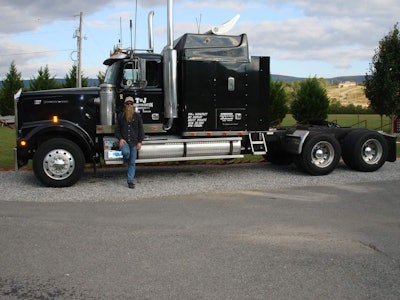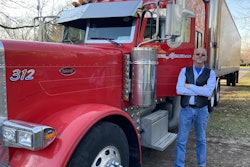In recent months, Overdrive has talked with dozens of owner-operators and small fleet owners about their experiences and their businesses through the COVID-19 economic downturn. In the coming weeks, we’re checking back in with many of them to see how they’re faring as the economy slowly begins climbing back.
 Timothy Barrett owns and operates the one-truck T&J Transportation out of East Tennessee. “You’d never guess,” he said, “my CB handle is ZZ.” He’s pictured here with his 1997 Western Star.
Timothy Barrett owns and operates the one-truck T&J Transportation out of East Tennessee. “You’d never guess,” he said, “my CB handle is ZZ.” He’s pictured here with his 1997 Western Star.Timothy Barrett still hasn’t run a load since April. The one-truck independent owner-operator hung up the keys in early April, choosing to keep his truck parked as long as rates remain below what he’s willing to run for.
“I can go broke two ways: Hauling for nothing or not hauling. I’m not going to [run loads] and exchange money for fuel and drive the truck for free,” he told Overdrive in April.
As of late last week — mid-June — the story’s still the same: “Rates are just ridiculous,” he said. Especially for the loads he was running before the pandemic hit the U.S. — hauling primarily loads of auto parts and for trade shows and events from Tennessee (Nashville, Knoxville and Chattanooga) and Atlanta to Arizona (Phoenix or Nogales) and back.
“Everything I normally do is still shut down,” he said. And rates for his typical loads “are $1,500 off of what I normally haul for.” His revenue on the loads from Tennessee or Georgia usually totaled between $2,700 to $3,200, he said. Those are going for about half that now, he says. One broker last week “had an Atlanta to Phoenix for $1,900. That’s 1,856 miles and paying $1,900. That’s just impressive,” he quipped.
He doesn’t have a truck or trailer payment, and he cut a deal with his insurer to pay a lower premium as long as he’s not running, so that he can maintain his authority. “I’m watching rates,” he said, and if he sees something he wants, he’ll take it. He told his insurer they’d be “the second to know, after me,” if he accepts a load offer.
Independent owner-operator Toma Tomov, out of Missouri, was in the same spot as Barrett in April. He too had decided to shut down when rates tumbled. Then, he was watching load boards daily for loads he’d accept. Like Barrett, he’s kept his costs down. He doesn’t have any equipment payments and was able to weather a few weeks without running.
He’s picked up a few loads in recent weeks to drum up what little cash he can. “Rates have changed a little bit. We’re not making any money, but we’re surviving,” he said. “I have to move. I can’t stay home forever.”
Tomov has been an independent owner-operator for 15 years, and he’s never seen rates so poor. “They should be double what they are,” he said. “But If you don’t have freight, there’s no market,” he added, acknowledging the tough truth that, without some carriers exiting the industry, rates are unlikely to move much. “Some of us have to fall out for it to balance itself out,” he said.
He runs a 2014 Volvo VNL, and he hauls refrigerated freight, which has seen its seasonal uptick in recent weeks as produce season arrived. That’s a small boost for now, “but that doesn’t last,” he said. As produce winds down, “I’m worried it’ll get worse than it was.”
Comments from Timothy Barrett and Toma Tomov appeared in these stories from April:










